| Card | Point Value |
|---|
| Each Ace | 11 |
| Each 10 | 10 |
| Each King | 4 |
| Each Queen | 3 |
| Each Jack | 2 |
| 9, 8 or 7 | 0 |
If the forehand managed to earn 61 or more card points he is determined to have won the hand. If however, the forehand player scores 60 or less points in card points the dealer is declared the winner of this hand.
The forehand player (declarer) then gains or loses a number of "game points" based on whether he wins or loses the hand. This scoring is very similar to standard skat.
- First, the number of Matadors for the declarer should be determined.
For each card in an unbroken sequence the declarer player has (starting with the highest trump card, the Jack of Clubs), he is considered to have one Matador. Similarly, if the player does not have the highest trump card, he is considered to have one
matador for each high card of the unbroken sequence he does not have. The total number of Matadors is one plus the number of matadors as determined for that player.
After the number of matadors is calculated, this number is multiplied by the base score based on the trump suit declared, as from the chart.
- After this score is calculated, additional multipliers are then calculated. If the opponent of the winner has earned no card points during the hand (Schwarz) the total points are quadrupled for the hand. If the opponent of the winner earned more than 0 points but fewer than 30 card points, the score is doubled instead.
- If the dealer doubled the hand, the score is also doubles and if the declarer redoubled, the score is quadrupled.
After the total game point score is calculated for the hand, it is either added or subtracted from the declarer. If he won the hand (by earning 61 or more card points during the hand) this number of game points is added to his ongoing score, however, if he scored fewer then 61 card points, this number is subtracted from his total ongoing game point score.
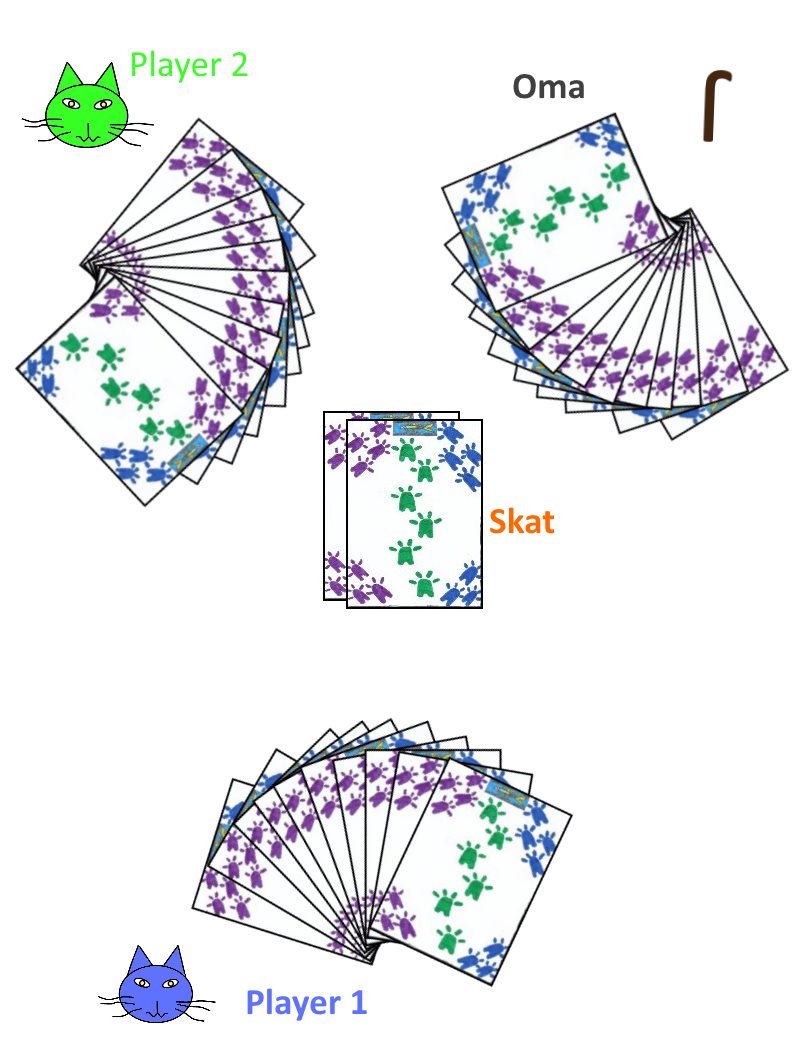 Oma Skat:
Oma Skat:
Oma Skat (or Grandmother's Skat) is another form of Skat designed to allow
skat to be played amongst two players. In this version three hands are still dealt, but there are only two active players. This variant sometimes goes by the name Dead Man's Skat or Blind Skat. In addition to a version played when two players want to engage in a hand of Skat, this variant is also sometimes used to introduce new players to the game of Skat, as this variant is somewhat easier to learn and play than the standard game.
In this variant, the deal is performed as if there were three active
players, with a hand dealt to the imaginary third player (the Grandma or
Grandmother's hand) as well as the usual two card skat in the center of the table. The bidding also occurs as normal, however the Grandma always passes, never bidding against either of the players.
There are actually two different methods for how the extra third hand is handled in the play of this game, one in which the extra hand participates and the other in which it does not. The following describes these differing methods:
|
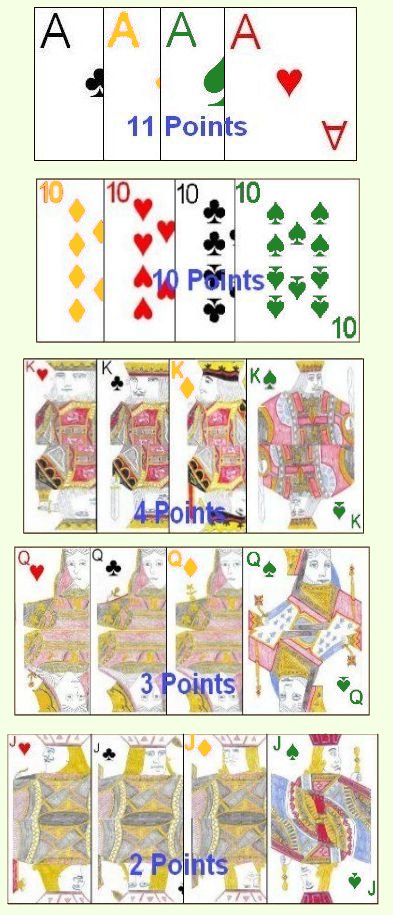
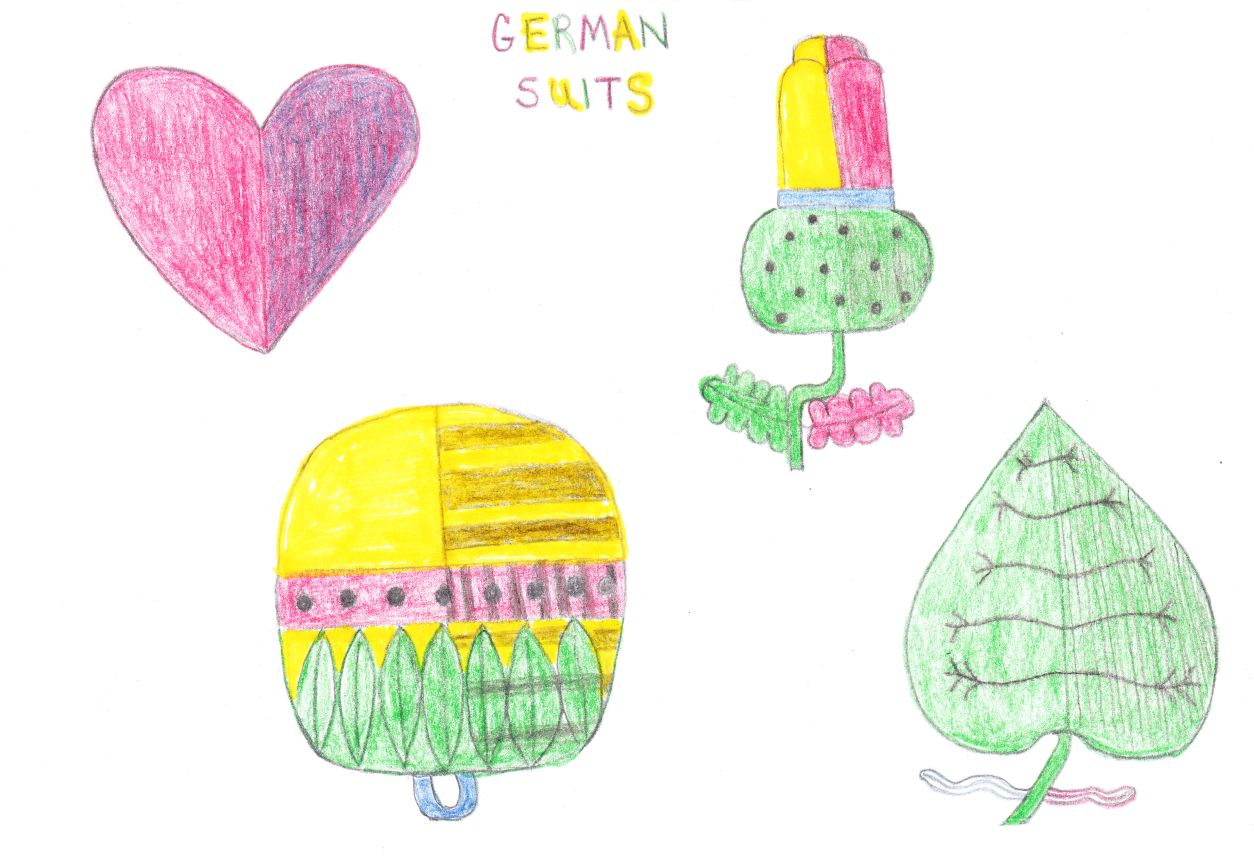 The game is played using a 32 card German deck, traditionally using a pack of German playing cards. Like the familiar French deck, the German deck is comprised of four suits. However, the four suits in a German deck are as follows; Acorns, Leaves, Hearts and Bells. Another difference in this German pack, is the Royalty or Face cards. In this deck, the Face cards consist of an Under Knave (marked with a U), Over Knave (indicated by a O), King (K) and Ace (A), one in each suit.
However, a standard French deck can, and often is, used to play. When using a French deck, it can be created from a standard deck stripped of all cards lower than 7. Thus, this Skat deck consists of one card of the denominations 7 through Ace in each of the four suits. Oftentimes, even the French decks used for traditional Skat are customized to some degree. This usually consists of special coloration of the four standard suits. The Spades (♠) are colored green, the Diamonds (♦) yellow, the Clubs (♣) are the expected black and Hearts (♥) are red.
The game is played using a 32 card German deck, traditionally using a pack of German playing cards. Like the familiar French deck, the German deck is comprised of four suits. However, the four suits in a German deck are as follows; Acorns, Leaves, Hearts and Bells. Another difference in this German pack, is the Royalty or Face cards. In this deck, the Face cards consist of an Under Knave (marked with a U), Over Knave (indicated by a O), King (K) and Ace (A), one in each suit.
However, a standard French deck can, and often is, used to play. When using a French deck, it can be created from a standard deck stripped of all cards lower than 7. Thus, this Skat deck consists of one card of the denominations 7 through Ace in each of the four suits. Oftentimes, even the French decks used for traditional Skat are customized to some degree. This usually consists of special coloration of the four standard suits. The Spades (♠) are colored green, the Diamonds (♦) yellow, the Clubs (♣) are the expected black and Hearts (♥) are red.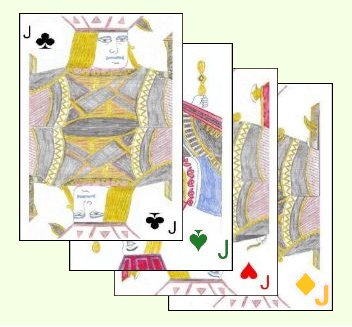 When a trump suit is used, the top four ranked cards of the Trump suit will always be as follows: Jack of Clubs, Jack of Spades, Jack of Hearts, Jack of Diamonds. Since the Jacks are a permanent part of the trump suit, the remaining cards of the trump suit would then rank as follows; Ace, 10, King, Queen, 9, 8, 7. The ranking for the three non-trump suits would also rank similarly; Ace, 10, King, Queen, 9, 8, 7. The four Jacks as described are considered to be members of the Trump suit, irregardless of the actual suit marked on that card. Thus, these cards can be played at any time a card of the trump suit could legally be played.
When a trump suit is used, the top four ranked cards of the Trump suit will always be as follows: Jack of Clubs, Jack of Spades, Jack of Hearts, Jack of Diamonds. Since the Jacks are a permanent part of the trump suit, the remaining cards of the trump suit would then rank as follows; Ace, 10, King, Queen, 9, 8, 7. The ranking for the three non-trump suits would also rank similarly; Ace, 10, King, Queen, 9, 8, 7. The four Jacks as described are considered to be members of the Trump suit, irregardless of the actual suit marked on that card. Thus, these cards can be played at any time a card of the trump suit could legally be played.
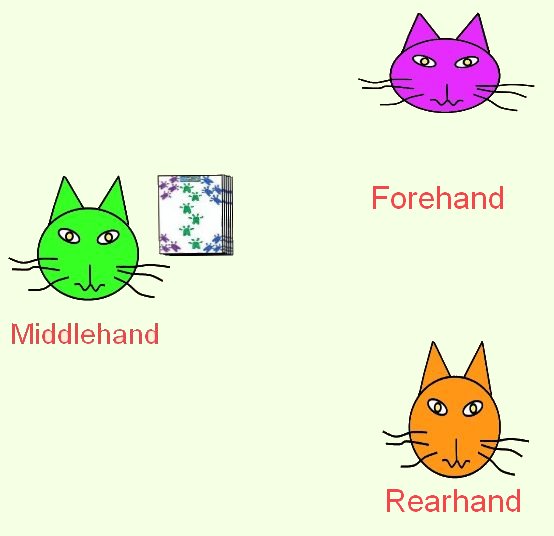 Once the dealing is complete, the players then pick up their hands for examination. Each position at the table is given a specific name in relation to the current dealer.
If there are four participants at the table, the dealer is simply called the dealer, but the other positions at the table have specific names. The player to the immediate left of the dealer is Forehand, the player directly across from the dealer is the Middlehand and the player to the dealer's right is the Rearhand. If there are three participants at the table the dealer takes the position of Middlehand, the player to his right is Rearhand and the player to his left is Forehand.
Once the dealing is complete, the players then pick up their hands for examination. Each position at the table is given a specific name in relation to the current dealer.
If there are four participants at the table, the dealer is simply called the dealer, but the other positions at the table have specific names. The player to the immediate left of the dealer is Forehand, the player directly across from the dealer is the Middlehand and the player to the dealer's right is the Rearhand. If there are three participants at the table the dealer takes the position of Middlehand, the player to his right is Rearhand and the player to his left is Forehand.
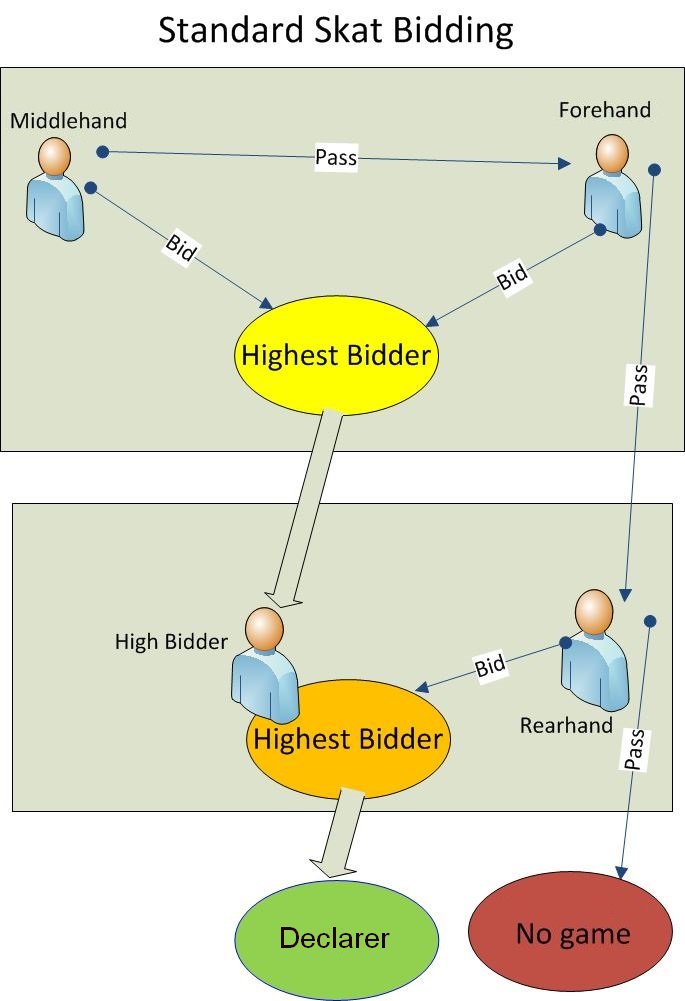 If Middlehand passes before making any bid, the bidding immediately proceeds between Forehand and Rearhand, with Rearhand required to name the first bid or pass. In the event that both Middlehand and Rearhand pass, Forehand may then name any bid or may pass. If he passes, the cards are thrown in with no score on the hand and the deal passes to the next player in turn.
If Middlehand passes before making any bid, the bidding immediately proceeds between Forehand and Rearhand, with Rearhand required to name the first bid or pass. In the event that both Middlehand and Rearhand pass, Forehand may then name any bid or may pass. If he passes, the cards are thrown in with no score on the hand and the deal passes to the next player in turn.

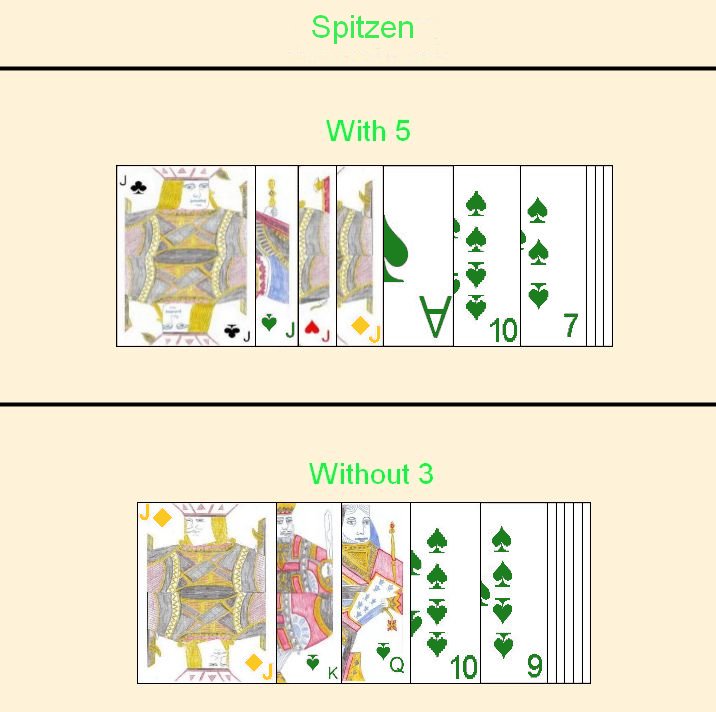
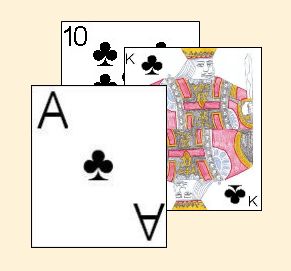
 As in Skat, each player is dealt 10 cards in packets of three, four and three. After the first batch of three card packets is distributed, a two card skat is dealt to the center of the table. As a reverse type of trick taking game, players normally attempt to win the least number of point scoring cards in tricks during the hand. The point values for the individual cards won in tricks is exactly the same as in standard Skat (Ace - 11, Ten - 10, King - 4, Queen - 3, Jack - 2, Lower cards - 0.)
As in Skat, each player is dealt 10 cards in packets of three, four and three. After the first batch of three card packets is distributed, a two card skat is dealt to the center of the table. As a reverse type of trick taking game, players normally attempt to win the least number of point scoring cards in tricks during the hand. The point values for the individual cards won in tricks is exactly the same as in standard Skat (Ace - 11, Ten - 10, King - 4, Queen - 3, Jack - 2, Lower cards - 0.)
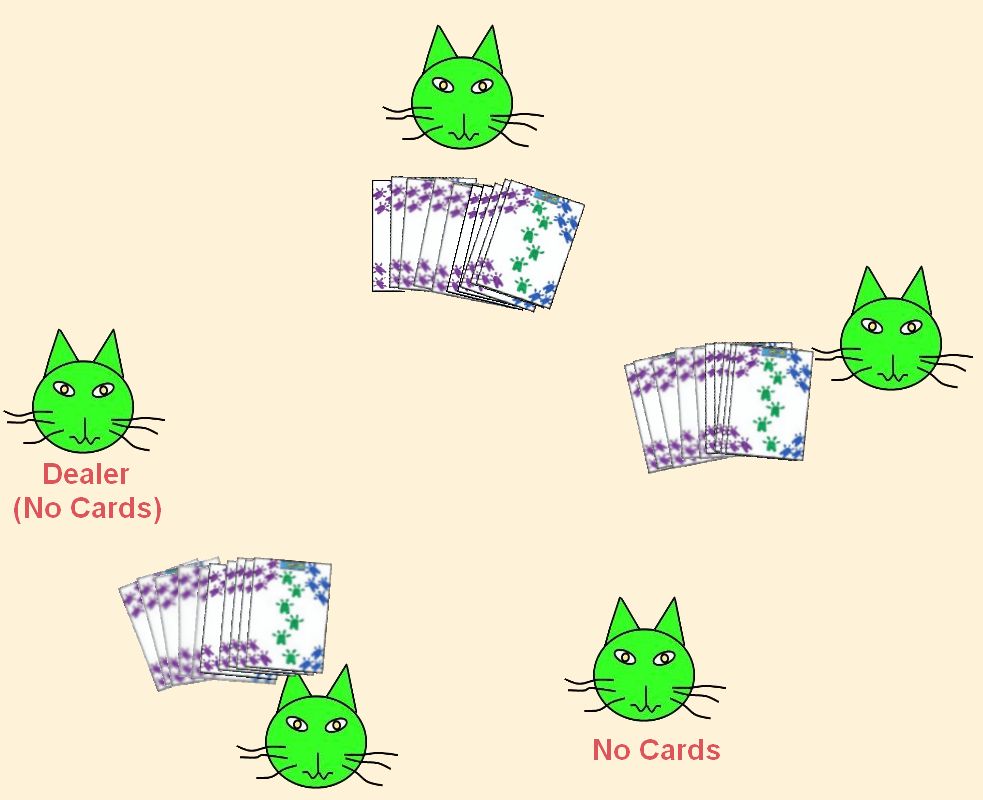 Skat With Additional Participants:
Skat With Additional Participants: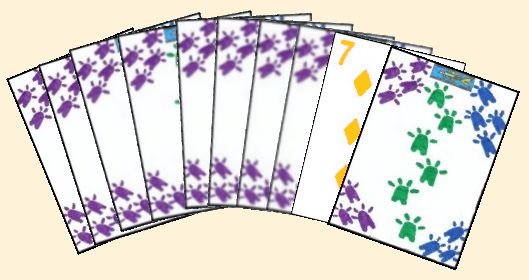
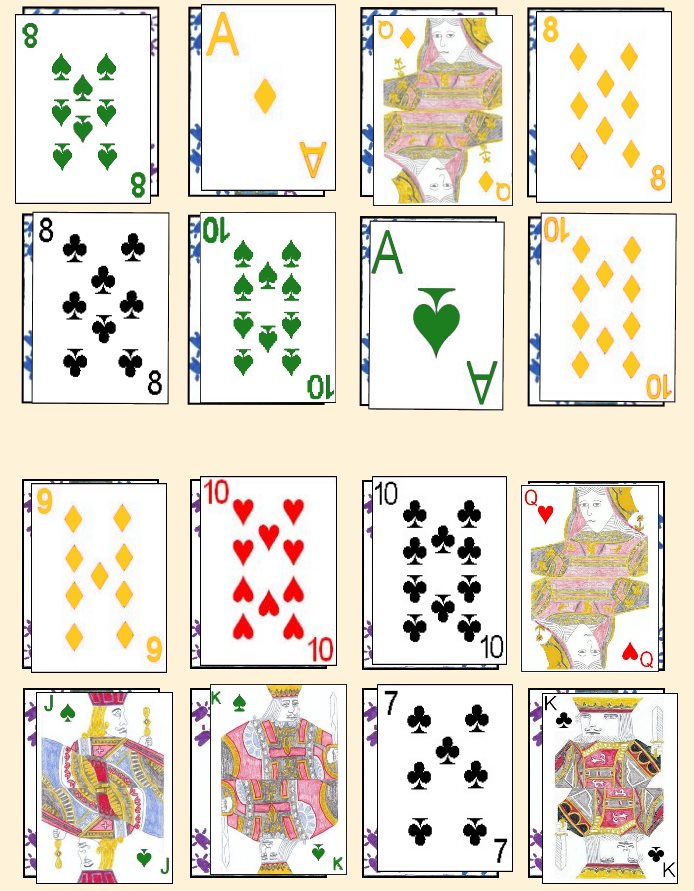
 Oma Skat:
Oma Skat: